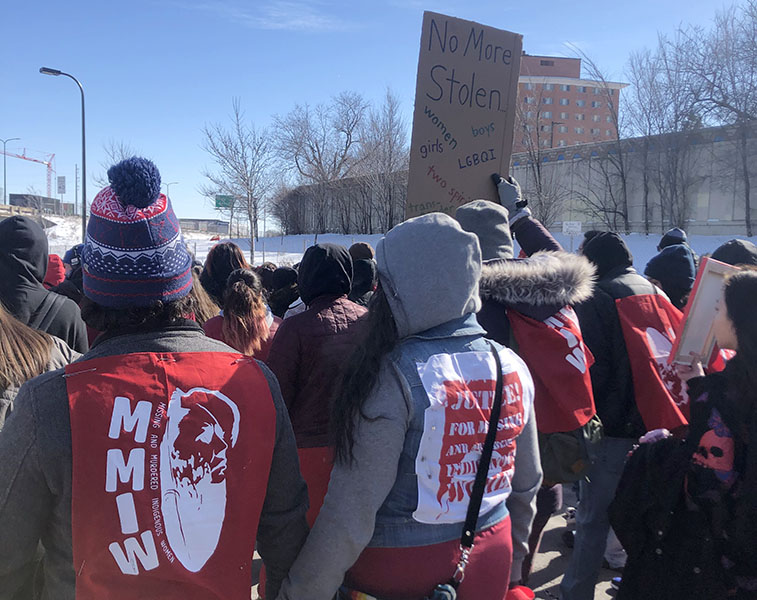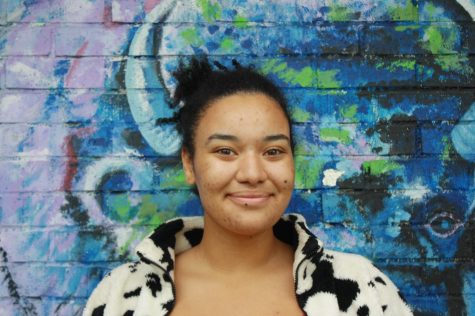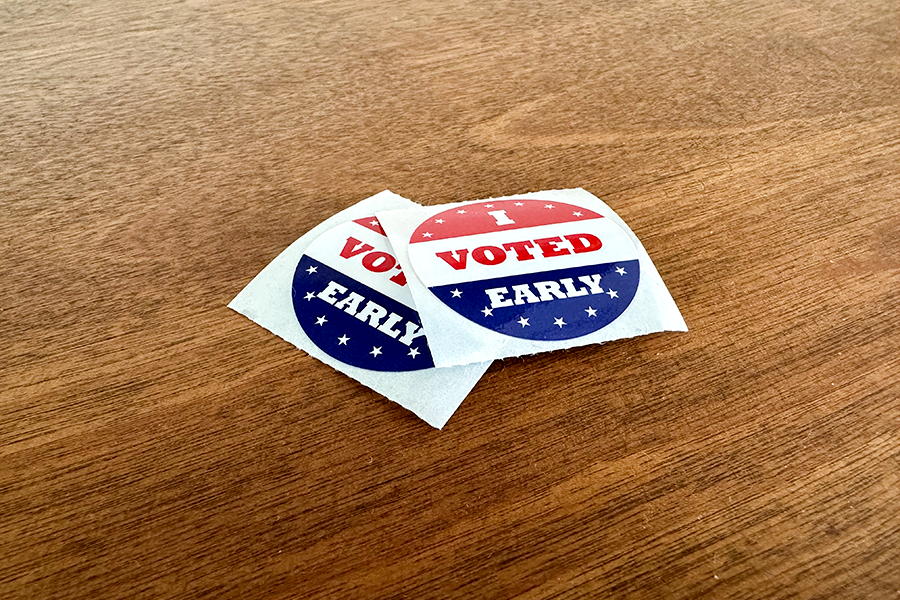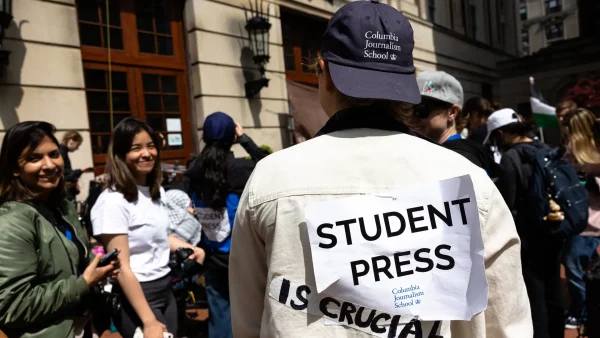MMIW Movement gets support from South community
Attendees of the march created red shirts, banners, etc. to bring light to the crisis and wore them to the march. Red is a symbol of the MMIW Movement.
February 27, 2020
On February 14th the streets in Ventura Village and East Phillips neighborhoods in South Minneapolis filled with red. But it was not to celebrate Valentine’s Day, it was to recognize the thousands of Indigenous women in Minnesota and across the country who are missing or have been murdered. Indigenous women face the highest rates of violence out of any racial group in the country. Yet, the media and government rarely ever report on it. According to the Indian Law Resource Center, the murder rate for Native American women in some areas is 10 times greater than the national average.
Red dresses hang on the corner of Cedar and 22nd avenue representing Native American women who have gone missing or have been murdered. The REDress Project was started by artist Jaime Black. Red dresses are hung in various environments to bring attention to MMIW.
South students and teachers have been going to the march for the past few years. “Last year was a big year, there were a lot of people and it was really empowering to have people show up like that. I think it brought a lot of attention to the cause,” said Kassie Benjamin, an All Nations math teacher. Despite freezing temperatures at this year’s march, the Minneapolis American Indian Center filled with people donning red, the color that is used to represent the Missing and Murdered Indigenous Women (MMIW).
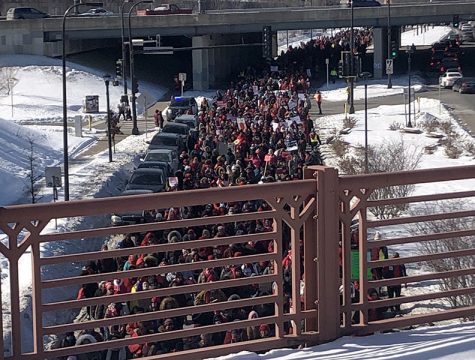
The Missing and Murdered Indigenous Women march on February 14th filled Franklin Avenue with people walking to raise awareness to an epidemic that gets little to no media attention. “Last year was a big year, there were a lot of people and it was really empowering to have people show up like that. I think it brought a lot of attention to the cause,” said Kassie Benjamin.
It is rare for popular media sources to cover MMIW. Indigenous newspapers are some of the only papers that consistently cover the crisis. “I like how it grows every year. There’s more coverage, more newspapers will come from the reservations up North and local Native papers like The Circle come,” said senior,
Selena Not Afraid, a 16 year old in rural Montana went missing on New Years Day. Her body was found a few weeks later less than a mile from where she was last seen. Unlike most Indigenous women who have been murdered or are missing, her story was covered by the popular media. The New York Times wrote an article on her murder and the MMIW movement. Looking through their website, a few times a year they write articles stating that there is a crisis.
“Indigenous populations are such a small amount of the US and MN as a whole and that’s due to genocide by our government which was intentional. Because we make up such a small population, I feel like anytime there’s data out there about us, a lot of the time it’s presented statistically insignificant. It’s often overlooked. It’s common, sadly too common for Native American’s to not see themselves in the discussion or included in media representation,” said Benjamin.
According to the Urban Indian Health Institute (UIHI), murder is the third-leading cause of death among American Indian/Alaska Native women. “It has reached a point where the community is getting together to raise awareness but that doesn’t mean this hasn’t been happening. It has been since the beginning of colonization,” said Logan Tootle, an employee at the Minnesota Indian Women’s Resource Center.
This epidemic of Indigenous women being murdered is not something new. The United States government and majority have sexualized and dehumanized Native American women since Europeans first colonized the country. Colonizers have twisted the narratives of figures like Pocahontas. B*tch Media, a feminist blog wrote “From Minaj’s post to ‘Pocahottie’ Halloween costumes to historical images of Indian maidens eager to be saved by white men, the sexualization of Native women is prominent in American pop culture.”
In both urban and rural Indigenous communities women and girls are being murdered and going missing. “This crisis is happening in rural areas because of issues of travel jurisdiction, so the few tribes who’ve applied for it have jurisdiction to be able to prosecute non-Indian offenders on tribal lands. Last time I check there were around 13 out of over 570 federally recognized tribes only in cases of domestic violence and sexual assault,” said Tootle.
There are a lot of dated laws in place to prevent Indigenous people from having tribal jurisdiction. The Indian Law Research Center stated that 88% of violent crimes against Native American women on reservations are committed by non-Indigenous people. According to B*tch Media, the Major Crimes Act of 1885 nearly prevented tribal jurisdiction, giving the US federal government control over felony crimes such as rape. Also, a 1978 Supreme Court case prevented Tribal Nations from trying and convicting non-Native American’s on tribal land because they would be “too biased.” Although some tribes are gaining jurisdiction these dated and racist laws still apply.
UIHI said in their report “despite this ongoing crisis, there is a lack of data and an inaccurate understanding of MMIWG, creating a false perception that the issue does not affect of-reservation/ village American Indian and Alaska Native communities.” Frequently, people think that MMIW/G only affects people in rural areas. “The fact that it is prominent in urban areas shows it’s not just a jurisdictional issue, it’s deeper than that. There’s a history of violence of Indigenous people on this continent and over-sexualization of Indigenous people,” said Tootle.
UIHI reported that in 2016, 5,712 missing and murdered Indigenous women were reported but only 116 were put in the US Department of Justice database. People are being reported but can’t even begin the journey of getting justice because the US government and police completely ignore the reports and crimes.
“We find out about things across the country because the Native community is such a small community. But we’re so big and connected. We’ll know about someone missing in Montana or murdered in New York because we have a tight community. The media isn’t covering it [MMIW], the news isn’t covering it. The only way we know about it is because youth councils across the country communicate,” said Martinez.
Victoria Alvarez, who would’ve been in the class of 2019, was murdered at the beginning of her freshman year. She was an Indigenous South High student, and her mother was also murdered. Say her name.


